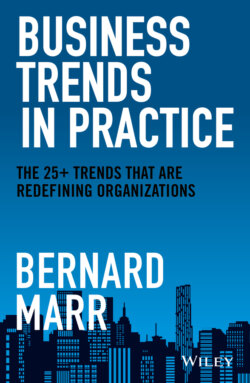Читать книгу Business Trends in Practice - Бернард Марр, Bernard Marr - Страница 22
Storing and processing data
ОглавлениеComputers have had to get faster and more powerful, in part to keep up with the vast amounts of data we're generating and processing. I talk more about the increasing datafication of our world later in the chapter, but it's clear that we're creating a vast amount of data on a daily basis. And the technology to store all that data is now significantly cheaper, more powerful, and easier to access. As a simple example, in the mid-1960s a terabyte of storage would have cost $3.5 billion; today I can buy a 1TB hard drive for less than $50.
Cloud computing (where data and applications are stored and processed on other people's computers) has played a critical role in the digital transformation we've seen in recent years, bringing huge advantages in terms of storing data cheaply, keeping data secure, and being able to process data more easily (most cloud providers offer AI and analytics services that can help you interrogate data at the click of a button).
So it's no surprise that as much as 80 percent of all enterprise and mission-critical workloads are predicted to move to the cloud by 2025.2 The cloud has become the backbone of the data-driven, app-based tech ecosystem that modern businesses operate in, and it continues to evolve. One trend that we can expect to see more of in cloud computing is multi-cloud approaches, or a breaking down of the barriers between different cloud service providers like Amazon, Microsoft, and Google. There are growing calls for the big providers to adopt a more collaborative approach and create bridges between their platforms, allowing, for example, an Amazon Web Services client to share data and access with a partner in their supply chain who works with Microsoft Azure.
Outside of the cloud, as devices have become more powerful, they've also been able to take on more of the processing grunt work. Known as edge computing, this means instead of pushing every bit of data to the cloud for analysis, some of it can be processed at the source, where the data was collected (i.e., in the device itself). This will become more important, and more useful, as 5G rolls out. Bringing with it superfast broadband and faster response times, 5G will make “the edge” much more powerful than it is today, effectively allowing us to turn everything around us into computers.
There are other data storage innovations to watch out for, the most exciting of which is DNA storage. Yes, you read that correctly. I'm talking about the ability to store data on DNA. Data centers are energy-hungry resources, and we can't ignore the impact all this data we're creating has on the planet. DNA-based storage could provide a solution to this problem, and a number of companies, including Microsoft, are working on DNA-storage technology. It's not as crazy as it sounds; DNA is already routinely sequenced (read), copied, and synthesized (written to), and storing DNA doesn't take much energy. What's more, DNA can store huge amounts of information – far more than any electronic devices. A block of DNA measuring just one cubic meter could meet the world's current data storage needs for a year.3 Which is just as well, because the rise of smart, connected devices – devices that are constantly gathering and generating data – shows no sign of slowing down.
